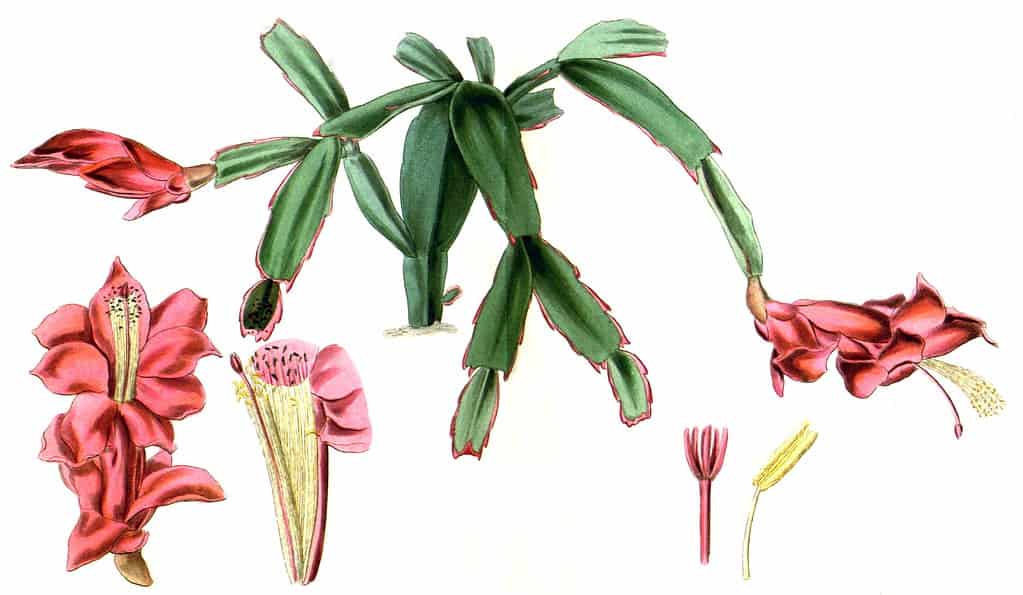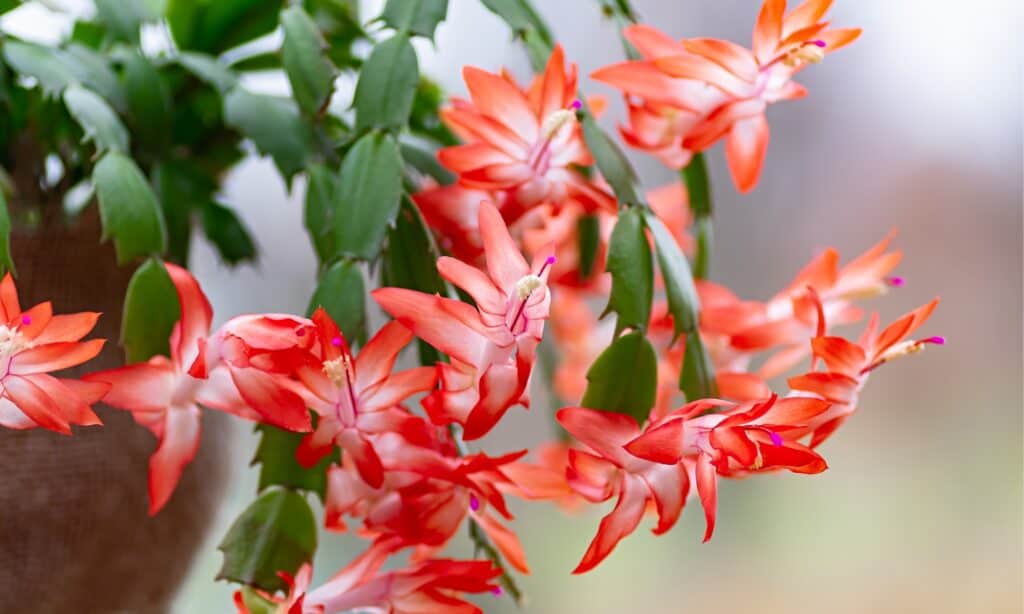The Thanksgiving cactus is a popular succulent houseplant, known in the northern hemisphere for its gorgeous, but notoriously finicky, winter blooms. Despite its particular flowering conditions, however, it is a great plant for beginner gardeners. Like most succulents, it is forgiving, hardy, and quite easy to care for. Where it differs from many other succulents and cacti is its place of origin and therefore the type of care it needs to thrive.
In this article, we’ll talk about where this unique cactus comes from and why its needs are different than you might expect. We’ll talk about those needs in greater depth, help outline a care routine, and find out how to help these finicky plants bloom in time for the holidays.
| Botanical Name | Schlumbergera truncata |
| Common Name(s) | Thanksgiving cactus, crab cactus, holiday cactus |
| Sunlight | Partial shade, 2–6 hours of indirect sun per day. Long exposure to direct sunlight can harm plant. |
| Water | Requires regular watering. Not a desert cactus. |
| Substrate | Light, well-draining, high in organic matter and/or grit. Orchid or succulent mix work well. |
| Indoor or Outdoor? | Partial shade, 2–6 hours of indirect sun per day. Long exposure to direct sunlight can harm plants. |
| Beginner Friendly? | Yes, easy to care for and propagate. Inducing flowering can be finicky. |
| Special Considerations | Needs long periods of heavy shade and darkness during the winter months to induce flowering. |
About the Thanksgiving Cactus
When you hear the word “cactus”, you might immediately picture a hot desert environment where the sun beats down and the rainfall is scarce. If you try to grow your Thanksgiving cactus in an environment like that, though, you and your plant will both struggle. While many cacti have adapted over millions of years to tolerate such extreme conditions, this species has adapted to an entirely different environment.
Native Habitat
Rather than the desert, the Thanksgiving cactus (Schlumbergera truncata), or crab cactus, hails from the tropical rainforests of southeastern Brazil. That’s right — the rainforest. This species of cactus thrives in the gentler lighting conditions and cooler temperatures offered beneath the forest canopy. Hot, dry weather and bright sunlight can do the plant serious harm.
The forests’ frequent rainfall and high humidity are also crucial for the Thanksgiving cactus, as it is an epiphyte. This means that it grows outside of the soil, above ground level, instead of clinging to the branches and sides of trees. It sometimes grows as a lithophyte, anchoring itself to rocks instead. Outside of the soil, the cactus must collect all of its water from rain events, condensation, and atmospheric moisture like fog and mist. Without access to the store of nutrients contained in the forest floor, the cactus must gather its nutrients in the same way. It relies on passing water to leach nutrients and deposit debris, decomposing plant matter, and animal waste onto its roots.
Many plant species have taken the same epiphytic approach to survival. Mosses and liverworts, Tillandsias like Spanish moss, and several orchid species are all great examples.
Classification
Perhaps surprisingly due to its epiphytic nature, the Thanksgiving cactus is considered a true cactus. It belongs to the family Cactaceae, right alongside its desert-dwelling relatives. It branches away from them further along the family tree, however. The cactus fits into the genus Schlumbergera which comprises a tight-knit group of six species. All of the cacti in this genus are forest-dwelling epiphytes that originate in Brazil’s mountainous rainforests.

A plate of
Schlumbergera truncatafrom W.J. Hooker’s “Exotic Flora (1823–27)”. The species has jumped through many classifications since then as biology has advanced and taxonomic conventions have changed.
©Hooker, William Jackson, SirBlackwood, William, publisher; Cadell, Thomas, publisher; Swan, Joseph, engraver, Public domain, via Wikimedia Commons – Original
Physical Characteristics
Thanksgiving cacti, or holiday cacti, earned their common name in the northern hemisphere for the timing of their blooms. Their flowers appear for several weeks in the fall and winter, usually around Thanksgiving. In the southern hemisphere, the cacti instead bloom around May and are subsequently called “Flor de Maio”, meaning “May flower”.
These cacti are leafless and instead use their modified stems to carry out photosynthesis. The stems grow in clusters and consist of many broad, flat, succulent pads which resemble crab claws, earning the species its other common name: the crab cactus. Each pad has several hair-producing notches, or areoles, along the sides and tip. All true cacti have areoles, which produce various types of defensive hairs and spines. If conditions are right, the cacti will also produce several colorful, tubular flowers from the areoles at the terminal ends of their stems.
While some of its relatives can to around 4 feet in height, Thanksgiving cacti tend to be much smaller. They will not usually exceed 12 inches in height and only grow about 2 feet wide, making them great potted houseplants. They are popular for this purpose and have been bred to produce a wide array of flower colors.
In Cultivation
Those who want to grow this beautiful cactus at home are in luck! It is widely available and sought after as an ornamental for its lush, green pads and beautiful blooms. Owing to its popularity, there are more than 200 cultivars on the market that produce flowers in a range of colors including red, pink, purple, and white. Many are even variegated.
Cultivars of Schlumbergera truncata belong to one of two groups — the Truncata group and the Buckleyi group. The former, derivatives of S. truncata, produce their flowers around November, hence the name Thanksgiving cactus. The flowers are held horizontally, or almost so, from the stem tips and produce yellow pollen. The cacti in the Buckleyi group, however, are crosses with S. bridgesii and produce their flowers later in the year, usually during December. These cultivars are referred to as Christmas cacti for their later bloom time. Their flowers produce pink pollen and are less erect, tending to hang down below the stem tips.
In the absence of flowers, the stems can also help you determine which group your plant belongs to. Cacti of the truncata group have longer, pointed teeth along the edges of their stem pads, whereas those of the Buckleyi group are much rounder.
Confusingly enough, many online and in-person stores will use the names Christmas and Thanksgiving cactus interchangeably without denoting the group that the cultivar belongs to. Luckily, the biggest difference between them is the bloom time. The care requirements are essentially the same.

Though the two groups look quite similar, Thanksgiving cacti of the truncata group have spikier leaf pads and flowers that grow horizontally from the stem tips.
©iStock.com/Elena Grishina
How to Care for a Thanksgiving Cactus
The Thanksgiving cactus is quite hardy and easy to keep alive, both indoors and outdoors. It isn’t overly picky about its placement throughout the year, and it can handle some dry spells here and there despite being a rainforest cactus. It can’t, however, handle the treatment you might give to a desert cactus like the barrel cactus.
To keep your cactus at its healthiest, you’ll want to do your best to mimic its native environment. There are also some special considerations to make to help your cactus live up to its holiday-blooming reputation.
Sunlight
In nature, the Thanksgiving cactus thrives in the partial shade of the rainforest canopy. It expects bright, often indirect light for 2–6 hours of the day. This is great news for indoor gardeners! Any room that is naturally bright for several hours per day will do, as long as the cactus isn’t directly in a sunny window.
If your cactus is growing outdoors, provide it with some shade during the afternoon hours when the sun is most intense. Some direct sunlight is okay, but too much can damage the stem pads and cause them to yellow. If you notice yellowing, you may need to adjust your plant’s placement.
Substrate and Watering
While these cacti originate in the rainforest, too much moisture can cause serious problems. In their native trees, their roots can shed excess moisture and dry out slightly between rain events. In cultivation, however, their roots are often confined to pots and planters, buried in potting medium. While this makes it easier for their roots to take in moisture and nutrients, it also leaves them more vulnerable to root rot and other moisture-related diseases.
When choosing a potting medium, or substrate, for your cactus, you need to make sure that it is well-draining. Most commercially available succulent or orchid mixes will do just fine. These soil-less formulas contain organic matter and grit of various sizes and are designed for drainage and aeration. As you gain experience growing these cacti, you may want to formulate a substrate that meets your plants’ individual needs.
A well-draining soil can help prevent roots from becoming waterlogged, but that’s only half the battle. You’ll also need to make sure you aren’t overwatering. We can’t tell you the exact number of days to wait in between watering, as your local climate affects how quickly your soil will dry out. To find out if it’s time to water, you can push your finger into the substrate to check for moisture. If much of the substrate feels dry, go ahead and give your plant some water. Over time, you’ll become familiar with your plant’s seasonal needs and you can develop your own personal watering routine.
Repotting Your Cactus
Keep in mind that any potting substrate containing organic matter will eventually need changing. Bark, moss, and other organic substrate components that improve drainage break down over time. Eventually, they break down so much that they can slow drainage, prevent oxygenation, and hold moisture for too long. While these particles might simply wash away in nature during heavy rain, they are usually unable to do so in cultivation. This can spell trouble for a potted epiphyte whose roots would otherwise be unconfined.
Another reason you might need to repot is to trim roots or increase the size of your plant’s pot. These are important practices to prevent many plants from becoming pot-bound or root-bound. Luckily, Thanksgiving cacti prefer to be fairly root-bound. Large, tangled roots displace moisture-holding soil, allowing the pot to quickly drain away excess moisture. While this would cause many geophytes to struggle, it creates conditions closer to what an epiphyte naturally expects.
Repotting intervals can vary from plant to plant and between individual substrate mixes. Usually, though, you’ll want to check your cactus’s pot every two or three years, trimming, sizing up, and refreshing substrate as necessary.
How to Help Your Cactus Bloom
The touchiest part of caring for a Thanksgiving cactus is helping it produce its blooms. This species and its relatives are thermophotoperiodic, which is a fancy way of saying that they rely on seasonal changes to produce their flowers. If the nighttime temperatures aren’t just right and the days are too long, they will produce very few blooms. Sometimes they won’t bloom at all.
To get good blooms out of your cactus, you need to make sure that it experiences long, cool nights. Temperatures that are too high can cause buds to fall off prematurely. In its native range, it expects 12 to 16 hours of complete darkness each night and temperatures between 50 and 55 degrees Fahrenheit. Yes, these are pretty specific conditions. However, they are achievable in most places with a little bit of planning.

In their native range, Thanksgiving cacti expect very early sunsets, cool temperatures, and long periods of complete darkness in the forest. Try to replicate these conditions to encourage blooming!
©Jody Partin/Shutterstock.com
In cooler temperate regions like the mountains of Tennessee or Kentucky, the fall weather may be just right to induce flowering without any extra input. If your cactus blooms on its own, all you have left to do is prevent it from getting too cold as temperatures drop into winter. In other locations where temperatures are right but light exposure is still too long, you may need to shelter your cactus from excess sunlight. This may be as easy as covering it with a dark cloth or cardboard box to block out the evening sun. Just don’t forget to take it off in the morning!
Indoors, you will want to keep your cactus in a cool room that remains unlit at night. Close the curtains to help the room darken early. If you need to, you can place your cactus in a dark closet at night and bring it out during the day.
Common Problems
These cacti are very hardy overall and are not susceptible to many pests or diseases. The most common problems arise when their care requirements are not well-met. Too much sun can cause scorching, shriveled pads, and yellowing of the stems. It can also dry out substrate quickly, causing parched roots and requiring more frequent watering.
As epiphytes, these plants are especially susceptible to root rot. It is crucial that you choose a well-draining substrate mix and that you do not overwater your cactus. Waterlogged roots can cause stem yellowing, wilting, and even a foul odor in advanced cases. By far the more common issue with these cacti, however, is underwatering. Remember that this isn’t a desert cactus!
How to Propagate Your Thanksgiving Cactus
Propagating a Schlumbergera cactus is very, very easy. Like most succulents, the best way to propagate your cactus is by taking a stem cutting during the spring or summer. To do this, simply cut a stem at one of its joints, in between two pads. To ensure that the cutting has enough water and nutrients to grow a new plant, include 3 or 4 pads in each cutting.
Once you have your cutting, leave it on the soil surface for two or three days so that the cut end can form a callus. Then simply plant it, cut the end down, into a container of fresh, moist potting mix to begin developing roots. You can apply rooting hormone at this step if you want, but it isn’t usually needed. To help maintain humidity, you can place a clear plastic bag or humidity dome over the pot if needed. Over the next several weeks, they will produce their first roots.
Thank you for reading! Have some feedback for us? Contact the AZ Animals editorial team.








